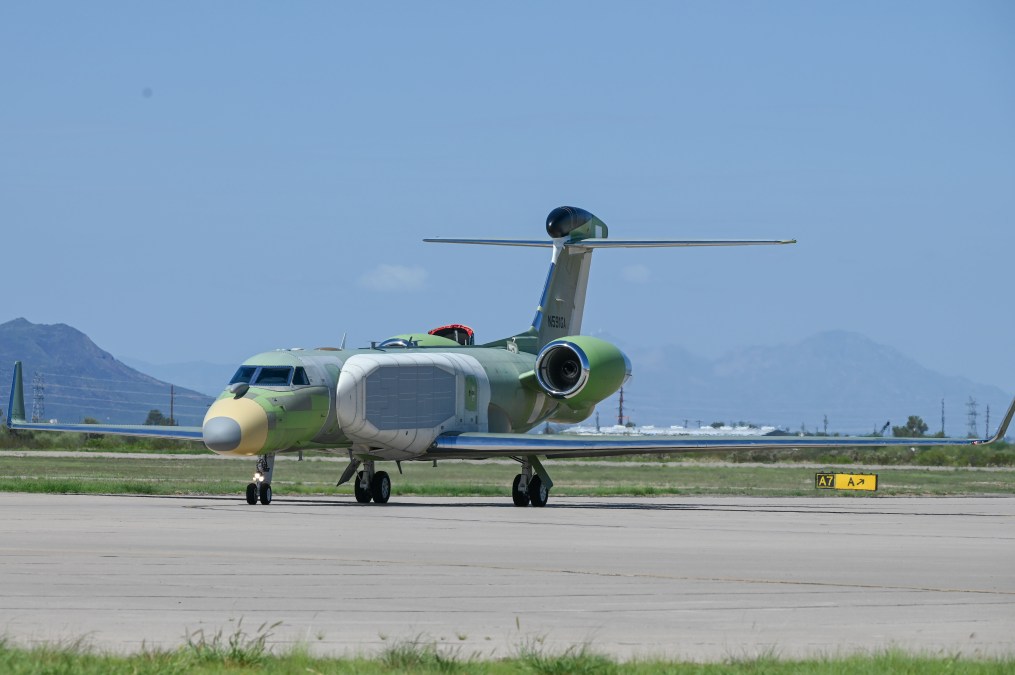MARK POMERLEAU

An EC-37B Compass Call arrives at Davis-Monthan Air Force Base, Arizona, Aug. 17, 2022. Compass Call suppresses air defenses by preventing the transmission of essential information between adversaries, their weapon systems, and control networks. (U.S. Air Force photo by Airman 1st Class Vaughn Weber)
In a first, the Air Force’s newest wing, focused on electronic warfare reprogramming, integrated with the service’s famed Weapons School to expose students to its capabilities and provide more realistic training.
The 350th Spectrum Warfare Wing was created in 2021 as a result of the Air Force’s landmark electromagnetic spectrum study to reinvigorate spectrum within the service. The unit has three primary missions: rapid reprogramming, target and waveform development, and assessment of the Air Force’s EW capabilities.
At Nellis Air Force Base, Nevada, in mid-December, the wing participated in the Weapons School Integration (WSINT) capstone event, which are several large missions involving planning and execution of all aspects of air, space and cyber operations — with joint components — serving as the culmination of what students learn at the school.
As the Air Force is looking to reinvigorate electronic warfare within its operations, exercising new capabilities and exposing the force to these capabilities will be important to ensure operators and planners understand EW tools and are comfortable using them in combat.
“Our objectives for the students were to demonstrate the SWW’s capability to help them solve the complex tactical problems presented by WSINT and to facilitate a realistic EW threat environment,” Maj. Matthew Adams, 16th Electronic Warfare Squadron division assistant director of operations, said. “Additionally, we helped ensure that the EW effects were incorporated into mission planning, execution and the debrief process.”
By integrating personnel from the wing, students from the Weapons School gained more realistic training scenarios through emulated war reserve modes through emitters — essentially the code, signals and waveforms for use only when a conflict breaks out so as enemies can’t develop remedies ahead of time. This allowed the students to find, track, engage and assess new threats to support combatant commander objectives.
Specifically, the wing sought to rapidly reprogram mission data files for priority combat platforms, acquire and analyze Crowd-Source Flight Data (CSFD), develop electronic warfare assessment and operation experience, and test the ability to download advanced mission applications in flight.
The wing’s commander has said the goal for addressing priority threats is to be able to reprogram capabilities in three hours.
In the cat-and-mouse game of EW and electromagnetic spectrum operations — where adversaries seek to deny access to the spectrum for communications or navigation through jamming — agility and speed are paramount. Once a signal is detected, forces must work to reprogram systems to counter it, which during the Cold War could take weeks to months as the signal had to be sent back to a lab, a fix devised, and then sent back to the field.
Modern forces are trying to use more digital means to reprogram systems in as near real-time as possible to stay ahead of threats.
“What we’re really doing is taking data from the edge, bringing it back to our engineers, creating new combat capability and pushing it back out to the edge as quickly as possible,” the wing’s commander, Col. Josh Koslov, said last year. “Our goal, our moonshot is three hours. What we think is that our ability to aggregate combat power against the pacing challenge will be kind of a pulsed way in three hours — seems like a good number for us to base what we’re trying to do on.”
According to the Air Force, the focus of electronic warfare at WSINT is in direct support to commander of Air Combat Command Gen. Mark Kelly’s priorities to incorporate electromagnetic spectrum operations into exercises so service members can train like they fight.
In fact, outside experts and members of Congress have recently stressed the importance of integrating electronic warfare into exercises more often and even doing more EW-specific training through ranges. In the past, many of these capabilities have just been injected through what is known as white carding, or simply telling exercise participants that their systems are jammed while not actually jamming them. This has led to concerns that warfighters haven’t actually seen the effects of these critical non-kinetic capabilities in training and might not be as combat ready as they should be.
No comments:
Post a Comment